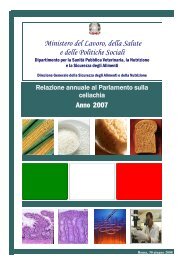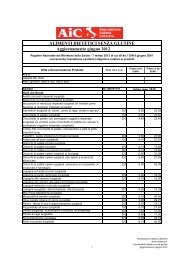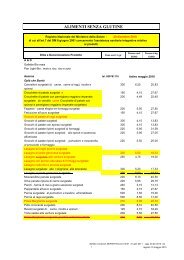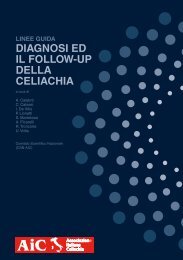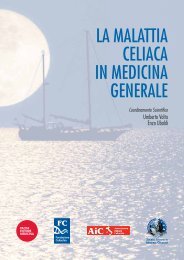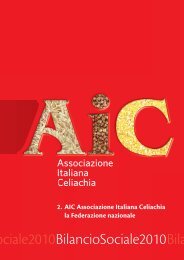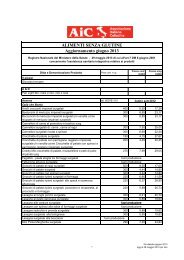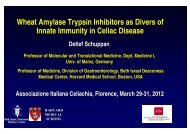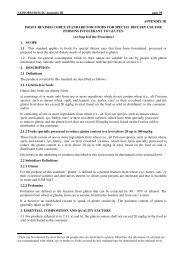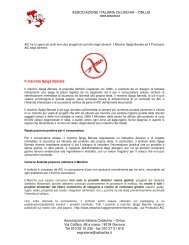primary prevention of coeliac disease - Associazione Italiana ...
primary prevention of coeliac disease - Associazione Italiana ...
primary prevention of coeliac disease - Associazione Italiana ...
You also want an ePaper? Increase the reach of your titles
YUMPU automatically turns print PDFs into web optimized ePapers that Google loves.
Catassi C, Fasano A, Corazza GR (eds):<br />
Primary <strong>prevention</strong> <strong>of</strong> <strong>coeliac</strong> <strong>disease</strong>. The<br />
utopia <strong>of</strong> the new millennium? Perspectives on<br />
Coeliac Disease, vol. 1, AIC Press, pp 31-41<br />
The association <strong>of</strong> the HLA-DQ molecules with<br />
<strong>coeliac</strong> <strong>disease</strong> in the Saharawi: an evolutionary<br />
perspective<br />
1 2<br />
Francesco Cucca and Carlo Catassi<br />
1<br />
Department <strong>of</strong> Biomedical and Biotechnologies Sciences, University <strong>of</strong> Cagliari,<br />
2<br />
Cagliari, Italy. Department <strong>of</strong> Pediatrics , University <strong>of</strong> Ancona, Ancona, Italy.<br />
The familial clustering <strong>of</strong> CD<br />
Coeliac <strong>disease</strong> (CD) is an immune-mediated enteropathy caused by the ingestion<br />
<strong>of</strong> wheat and other gluten-containing cereals (rye, barley) in genetically predisposed<br />
1<br />
individuals . CD is strongly clustered in families as illustrated by the sibling lifetime<br />
2-3<br />
risk/population prevalence ratio, lequal s to 30-60 in different studies . These<br />
epidemiological observations indicate the strong influence <strong>of</strong> genetic factors in the<br />
<strong>disease</strong> predisposition. This is also strongly suggested by the recurrence risk <strong>of</strong> 70-<br />
4<br />
100% observed in monozygotic twins (MZ) . Twin studies are particularly important<br />
for human geneticists because the risk in MZ twins provides a direct estimate <strong>of</strong><br />
penetrance (the effect <strong>of</strong> the genotype on the phenotype) for the whole complement <strong>of</strong><br />
susceptibility alleles at multiple loci. While it is necessary to extend these preliminary<br />
studies in larger cohorts <strong>of</strong> twins, the fact that the recurrence risk might not be 100%,<br />
and thus that the penentrance is incomplete, might indicate that other modifying<br />
epigenetic factors, such as the stochastic rearrangements <strong>of</strong> the T-cell receptor, and/or<br />
other environmental factors (in addition to the gluten in the diet) could also be involved<br />
in CD.<br />
The contribution <strong>of</strong> genes located in the HLA region to CD predisposition<br />
The major histocompatibility complex (MHC) human leukocyte antigen (HLA)<br />
region on chromosome 6p21 contains the major and, so far, the only consistently<br />
confirmed genetic component for CD predisposition. The HLA/MHC contains a<br />
densely packed array <strong>of</strong> at least 150 genes in 3,500 kb <strong>of</strong> DNA. Proteins encoded within<br />
the HLA region determine the way in which antigens are processed, translocated and<br />
presented to T-lymphocytes. During development <strong>of</strong> the T cell repertoire, HLA class I<br />
and class II molecules control positive and negative selection <strong>of</strong> the T-lymphocytes in<br />
the thymus. Not surprisingly, therefore, genes in the HLA region influence<br />
susceptibility to a large number <strong>of</strong> disorders, particularly autoimmune <strong>disease</strong>s.<br />
31





